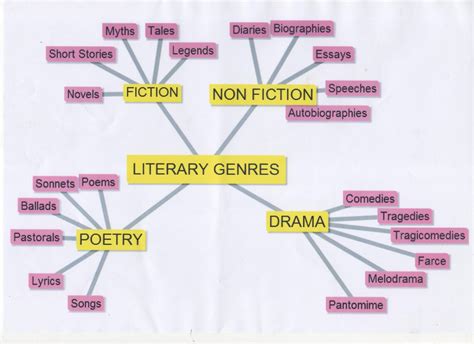In the realm of literature, genres and literary movements serve as organizing frameworks that help us categorize and understand works of literature based on their unique characteristics and shared qualities. From the epic poetry of ancient Greece to the postmodern novels of the 20th century, genres and literary movements have shaped the literary landscape for centuries.

Genres: The Building Blocks of Literature
Genres are broad classifications of literature that group works based on their subject matter, style, and form. They provide a useful way to navigate the vast ocean of literary works, allowing readers and scholars to identify and compare similar pieces.
Common Literary Genres
- Fiction: Narratives that are imaginary and invented, including novels, short stories, and plays.
- Non-Fiction: Works that present factual information, such as biographies, histories, and essays.
- Poetry: Verse that expresses thoughts and emotions through language, rhythm, and imagery.
- Drama: Plays that tell stories through dialogue and action, often performed on stage.
Literary Movements: The Tides of Literary Evolution
Literary movements are groups of writers who share similar artistic principles and techniques. They often emerge as reactions to previous movements or as a response to social and cultural changes.
Major Literary Movements
- Romanticism: A 19th-century movement that emphasized emotion, imagination, and the beauty of nature.
- Realism: A 19th-century movement that focused on realistic and unbiased depictions of society and everyday life.
- Modernism: A 20th-century movement that experimented with language, form, and narrative structure.
- Postmodernism: A late 20th-century movement that rejected traditional notions of truth and meaning.
Genres and Literary Movements: A Dynamic Relationship
Genres and literary movements are not mutually exclusive. Works of literature can belong to both a genre and a movement, demonstrating the fluidity and complexity of literary expression. For example, the novel “The Great Gatsby” by F. Scott Fitzgerald can be classified as both a work of fiction and a product of the Modernist movement.
Quick Check
To assess your understanding of genres and literary movements, complete the following quick check:
- What is the primary purpose of literary genres?
- Name three common literary genres.
- Which literary movement emphasized imagination and emotion?
- What is the key characteristic of Modernist literature?
Effective Strategies for Understanding Genres and Literary Movements
- Read widely: Explore a variety of works from different genres and movements to develop a broad literary perspective.
- Analyze common features: Identify the shared characteristics of works within a particular genre or movement, such as themes, style, and structure.
- Consider historical context: Understand the social and cultural factors that influenced the development of genres and movements.
Common Mistakes to Avoid
- Oversimplifying: Genres and literary movements are complex and nuanced, so avoid reducing them to simple labels.
- Confusing genre with movement: Remember that genres and movements are distinct concepts, although they can overlap.
- Assuming exclusivity: Works of literature can belong to multiple genres and movements, so avoid rigid categorization.
Comparing Genres and Literary Movements
| Genre | Key Features | Literary Movement | Key Features |
|---|---|---|---|
| Fiction | Imaginary narratives | Romanticism | Emphasis on emotion and imagination |
| Non-Fiction | Factual information | Realism | Realistic portrayal of society |
| Poetry | Verse expressing thoughts and emotions | Modernism | Experimentation with language and form |
| Drama | Stories told through dialogue and action | Postmodernism | Rejection of traditional notions of truth and meaning |
Conclusion
Genres and literary movements are indispensable tools for understanding and navigating the vast world of literature. By recognizing the distinct characteristics and shared qualities of different genres and movements, we can appreciate the full spectrum of literary expression and deepen our engagement with works of literature.
